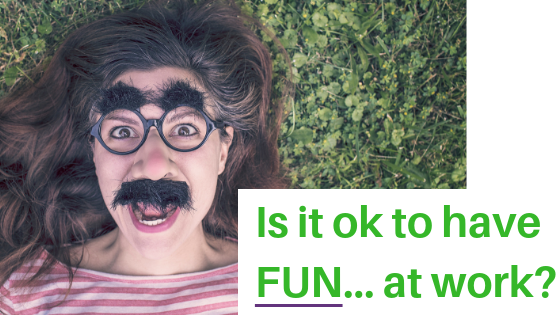We’ve all experienced it: That one person who always appears to be mucking around. They’re cheerful all the time, they have fun with what they do. They might have fun things or figurines on their desk, and they laugh – a lot! And loudly!
Everyone else has his or her nose to the grindstone. They’re very diligently and quietly going on with their work, and they’re all busy, all the time.
Imagine, then, when our cheery friend swings around on his chair to make a comment to someone about something. And instead of finding a smile, he is on the receiving end of some dark looks.
If this happens enough, our cheery friend gets cynical, maybe sharp.. He might start smoking more. He might start asking–persistently– for a pay-rise.
What’s going on?
Well, it could be that your employee isn’t taking his job seriously. Or it could be that you have a toxic workplace.
Maybe you just need to have more fun at work?
Positive emotions put the brake on negativity… and negativity can cut off positivity
The researcher Dr Barbara Fredrickson likens the relationship between positive and negative emotions to water lilies. Water lilies retract and close up when the sun sets. In the same way, when someone is threatened with a negative emotion – like our friend above – the mind constricts. While there might not be an imminent threat, the mind may assume there is one. In our example, the result was that our employee became more insular and self-focused.
‘Just as water lilies retract when sunlight fades, so do our minds when positivity fades,’ said Fredrickson.1
Behavioural researcher Robert Provine has done more scientific study into why we laugh, than almost anyone else. He points out that laughter isn’t necessarily a conscious choice.
‘We have the illusion that laughter is a choice,’ Provine said.2 ‘That we speak laughter as we speak any other word. But we don’t speak ‘ha ha’ when we laugh. It’s an involuntary action.’
Provine points out that it’s when we gather together with other people, who are engaging in the same kinds of behaviour, that we laugh.
‘In our feel-good, be-happy society, we always associate laughter with positive things,’ Provine explained, ‘forgetting that laughter also has a dark side. It’s great laughing with friends, family, lovers. But can be painful, or even dangerous, if you’re laughing at someone, or they’re laughing at you.’
This is a great explanation for why positive cultures appear light-hearted.
It might be why laughter can be a good metric.
Forbes magazine pointed out that where there is ‘laughter, joy, and fun, high performance teams thrive’.3 And, similarly, Spanx creator Sara Blakely believes that ‘having fun and kicking arse at work are not mutually exclusive’.4
There are simply loads of articles explaining how to have more fun at work.
The fastest way to lift energy at work is to laugh
Despite all of laughter’s negative connotations, it really is the fastest way to shift your own energy, and the energy of your workplace.
Laughter can:
- relieve tense situations
- drops your blood pressure (increases your ability to deal with stress)
- bring people closer together
- improve circulation (and help you think more clearly)
- prevent disease
… and it makes you just feel good! If you don’t believe me, stand and fake-laugh for 5 minutes.
Your body and your mind can’t tell that it isn’t real. And you’ll feel great afterwards.
You want to know the best thing about laughing?
Ten minutes of laughing burns more calories than half an hour of cardio exercise.8
Here’s how to shift your workplace into a new gear
Even if you’re in a toxic workplace, you can help your team to shift its energy, really quickly.
Here are six ways you can do it:
- Do something silly that makes you smile. Like, wave like you were a kid in the back of a car!
- Fake a laugh until you really are laughing
- Get your whole team to fake laughing until they are all laughing
- Attempt to be funny when your team least expects it. It’s more important to make an attempt than to be a comedian!
- Make telling a funny story part of your daily ritual
- Set a goal to open and end every meeting with laughter.
In Conclusion
Having fun at work might mean that the job is perfect for you, or that you are in a workplace with a positive culture. Just because we have a cultural understanding that work should be serious, it doesn’t mean you need to comply. Have some fun, improve your team, improve your health, and start hitting big goals much more easily.
Remember, teams that have fun together thrive together.
Give your team the high energy it needs to smash this year’s goals, with The ORANGES Toolkit
The E in ORANGES stands for Energy, which is what you get when you have fun!. It’s the sixth of seven workshops delivered over a two-day program. The program empowers your team members to learn and use 40 mindset-improvement strategies, which have an incredible impact on workplace cultures. The program is so impactful that participants can put the strategies in place immediately.
The ORANGES Toolkit isn’t a fluffy wellbeing program. It draws on the latest thinking in psychology and neuroscience, which is why it works.
The proof is in the pudding: Here is one case study that shows how well the program can transform your culture from pessimism to optimism.




Leave A Comment